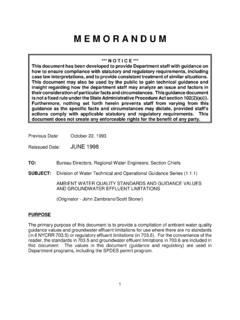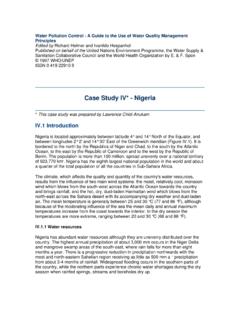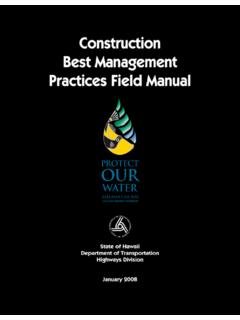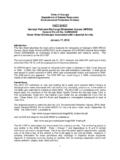Transcription of CHAPTER 6. Water Quality-Based Effluent Limitations
1 September 2010 NPDES Permit Writers Manual CHAPTER 6: Water Quality-Based Effluent Limitations 6-1 CHAPTER 6. Water Quality-Based Effluent Limitations When drafting a National Pollutant Discharge Elimination System (NPDES) permit, a permit writer must consider the impact of the proposed discharge on the quality of the receiving Water . Water quality goals for a waterbody are defined by state Water quality standards. By analyzing the effect of a discharge on the receiving Water , a permit writer could find that technology- based Effluent Limitations (TBELs) alone will not achieve the applicable Water quality standards. In such cases, the Clean Water Act (CWA) and its implementing regulations require development of Water Quality-Based Effluent Limitations (WQBELs).
2 WQBELs help meet the CWA objective of restoring and maintaining the chemical, physical, and biological integrity of the nation s waters and the goal of Water quality that provides for the protection and propagation of fish, shellfish, and wildlife and recreation in and on the Water (fishable/swimmable). WQBELs are designed to protect Water quality by ensuring that Water quality standards are met in the receiving Water . On the basis of the requirements of 40 CFR (a), additional or more stringent Effluent Limitations and conditions, such as WQBELs, are imposed when TBELs are not sufficient to protect Water quality . Exhibit 6-1 illustrates the relationship between TBELs and WQBELs in an NPDES permit, as well as the determination of final Effluent Limitations .
3 Exhibit 6-1 Developing Effluent Limitations CWA section 301(b)(1)(C) requires that permits include any Effluent Limitations necessary to meet Water quality standards. As illustrated above, to satisfy that requirement, permit writers implement a process to determine when existing Effluent Limitations ( , TBELs) and existing Effluent quality are not sufficient to comply with Water quality standards and to, where necessary, develop WQBELs. Exhibit 6-2 illustrates the four basic parts of the standards-to-permits process used to assess the need for and develop WQBELs. September 2010 NPDES Permit Writers Manual 6-2 CHAPTER 6: Water Quality-Based Effluent Limitations After completing that process, the permit writer determines the final Effluent Limitations , includes any compliance schedules and interim Effluent Limitations , as appropriate, and documents all his or her decisions and calculations.
4 Exhibit 6-2 Standards-to-permits process This CHAPTER provides basic information on the standards-to-permits process. For more detailed information on Water quality standards and Water Quality-Based permitting, and some of the specific topics discussed in this CHAPTER , refer to the NPDES Website < > and Water quality Standards Website < >. Determine Applicable Water quality Standards CWA section 303(c) and Title 40 of the Code of Federal Regulations (CFR) Part 131 establish the framework for Water quality standards. The CWA and implementing regulations require states to develop and, from time to time, revise Water quality standards applicable to waters of the United States, or segments of such waterbodies, that are in the jurisdiction of the state.
5 States must review their Water quality standards at least once every 3 years and revise them as appropriate. Wherever attainable, Water quality standards should protect Water quality that provides for the protection and propagation of fish, shellfish and wildlife, and recreation in and on the Water ( , the CWA section 101(a)(2) fishable/swimmable goal). In establishing standards, states must consider the use and value of their waters for public Water supplies, propagation of fish and wildlife, recreation, agriculture and industrial purposes, and navigation. The Environmental Protection Agency (EPA) has provided information regarding procedures for developing Water quality standards in the Water quality Standards Regulation at Part 131 and EPA s Water quality Standards Handbook: Second Edition1 < > (hereafter WQS Handbook).
6 Under CWA section 510, states may develop Water quality standards that are more stringent than those required by the CWA. September 2010 NPDES Permit Writers Manual CHAPTER 6: Water Quality-Based Effluent Limitations 6-3 EPA Regions review and approve or disapprove new and revised Water quality standards adopted by states. The purpose of EPA s review is to ensure that the new and revised Water quality standards meet the requirements of the CWA and the Water quality Standards Regulation. Water quality standards adopted and submitted to EPA after May 30, 2000, must be approved by EPA before they may be used to implement the CWA ( , used in NPDES permitting). If an EPA Region disapproves a submitted new or revised state Water quality standard, and the state does not adopt the necessary changes within 90 days of notification of the disapproval, EPA must promptly propose and promulgate a replacement standard [see (a)].
7 When writing an NPDES permit, the permit writer must identify and use the state Water quality standards in effect for CWA purposes. EPA maintains a compilation of current state Water quality standards on the Water quality Standards: State, Tribal, & Territorial Standards Website < >. In addition, EPA s Water quality Standards: Laws and Regulations Website < > provides federally promulgated standards applicable to specific states. The remainder of this section provides permit writers with a general overview of Water quality standards and how they are implemented in NPDES permits. Components of Water quality Standards Water quality standards comprise three parts: Designated uses. Numeric and/or narrative Water quality criteria. Antidegradation policy.
8 Each of those three components, along with general policies that also may be included in state Water quality standards, is described below. Designated Uses ( ) The first part of a state s Water quality standards is a classification system for waterbodies based on the expected uses of those waterbodies. The uses in this system are called designated uses. The regulations at (a) describe various uses of waters that are considered desirable and that must be considered when establishing Water quality standards. Those uses include public Water supplies, propagation of fish, shellfish, and wildlife, recreation in and on the Water , agricultural, industrial, and other purposes including navigation. The regulations allow states to designate more specific uses ( , cold Water aquatic life) [see (c)] or uses not specifically mentioned in the CWA, with the exception of waste transport and assimilation, which are not acceptable designated uses [see (a)].
9 States must also consider and ensure the attainment and maintenance of the Water quality standards of downstream waters when establishing designated uses [see (b)]. The regulations in (j) effectively establish a rebuttable presumption that the uses in CWA section 101(a)(2) (fishable/swimmable) are attainable. If a state fails to designate a given waterbody for such uses, or wishes to remove such uses, it must provide appropriate documentation demonstrating why such uses are not attainable. This analysis is commonly called a Use Attainability Analysis (UAA) (see (g) and section below. September 2010 NPDES Permit Writers Manual 6-4 CHAPTER 6: Water Quality-Based Effluent Limitations Water quality Criteria ( ) The second part of a state s Water quality standards is the set of Water quality criteria sufficient to support the designated uses of each waterbody.)
10 EPA s Water quality Standards Regulation at (a) requires states to adopt Water quality criteria using sound scientific rationale and to include sufficient parameters or constituents to protect the designated use. If a waterbody has multiple use designations, the criteria must support the most sensitive use. The regulation at (b) allows states to adopt both numeric and narrative Water quality criteria. Numeric Water quality criteria are developed for specific parameters to protect aquatic life and human health and, in some cases, wildlife from the deleterious effects of pollutants. States establish narrative criteria where numeric criteria cannot be established, or to supplement numeric criteria. Criteria newly adopted or revised on or after May 30, 2000, do not become effective for purposes of the CWA until approved by EPA (see (c)).

















